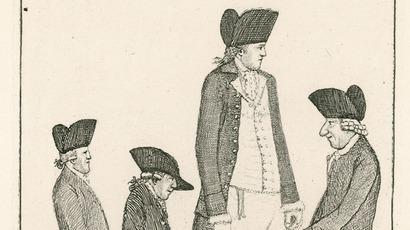The 2.30m skeleton of Charles Byrne will no longer be on display at the museum.
Almost two and a half centuries after his death, the news is a small step in respecting the last wishes of the
“Irish giant”
.
Born in 1761 in the north of Ireland, Charles Byrne suffered from gigantism, due to an undiagnosed benign tumor of the pituitary gland.
His peculiarity became an attraction, and his livelihood: people paid two shillings to see what was reputed to be the tallest man in Georgian England.
His notoriety attracted the interest and covetousness of John Hunter, an eminent surgeon at St. George's Hospital in London, who, the establishment recalls on its website, makes no secret of his intentions to get his hands on the body. by Charles Byrne for his collection.
Horrified by this idea, the
“Irish giant”
asks that when he dies, his body be immersed in the sea. Charles Byrne has his savings stolen, sinks into alcohol and is found dead in his London apartment in 1783 at the 22 years old, no issue.
A newspaper at the time described a
"tribe of surgeons"
surrounding his home as
"harpooners"
around an
"enormous whale"
.
'Not ethical'
Three years later, Charles Byrne's skeleton appears, exhibited in John Hunter's museum in London.
His body was stolen and replaced with dead weights in the coffin as he reached the coastal town of Margate on his final seaward journey. Sources say Hunter paid £500 to friends of the
“giant” »
.
Acknowledging the
“sensitivities”
and
“different points of view”
around the exhibition of the skeleton and its conservation, the Hunterian museum in London recently announced that it would no longer be on public display when the establishment reopens, scheduled for March after five years of work.
"John Hunter (1728-1793), other 18th and 19th century anatomists and surgeons acquired many specimens by means that would not be considered ethical today
," the trustees of the Hunterian Collection have pointed out. .
Read alsoWhen science was wrong: when giants populated the earth
They also announced the launch of a program devoted to issues
“surrounding the display of human remains and the acquisition of specimens during British colonial expansion”
in the fall.
The removal of the skeleton from the museum is
"wonderful news"
, welcomed Thomas Muinzer, lecturer at the University of Aberdeen, who has campaigned for years for Charles Byrne's wishes to be respected.
But this is only a
"partial success"
, he laments to AFP.
His last wishes: immersed in the sea
The skeleton will remain preserved to allow research and to maintain the integrity of the collection.
Arguments that hardly convince Thomas Muinzer, considering that the skeleton has been widely studied, its complete DNA has been extracted from it, and patients with the same pathology still exist today.
The lawyer had discovered the story of Charles Byrne in a moment of boredom, when he was a student at the University of Belfast.
He then fell in love with this
"famous forgotten character"
and realized that the exposure of his skeleton persisted: an
"injustice"
that must be corrected.
In 2011, Thomas Muinzer had pleaded the cause of Charles Byrne by publishing with Len Doyal, emeritus professor of medical ethics at Queen Mary University of London, an article in the British Medical Journal, for it to be "
hidden from the eyes of the public”
and
“immersed at sea in accordance with his last wishes”
.
What led Charles Byrne to want to avoid being buried on the ground no longer applies today, he underlines.
“We no longer have to worry about”
the
“resurrectionists”
of 18th and 19th century England and their traffic in corpses.
Read alsoAn ancient Viking site discovered in Cork would be the oldest in Ireland
The British writer Hilary Mantel, who died last September and who wrote a fictional portrait of the
"Irish giant"
had brought her voice to the mobilization, even believing that it was time to repatriate the remains of Charles Byrne to her native island.



/cloudfront-eu-central-1.images.arcpublishing.com/prisa/6UILSHI4OVDJJMD2GLI5FLRMZY.jpg)





